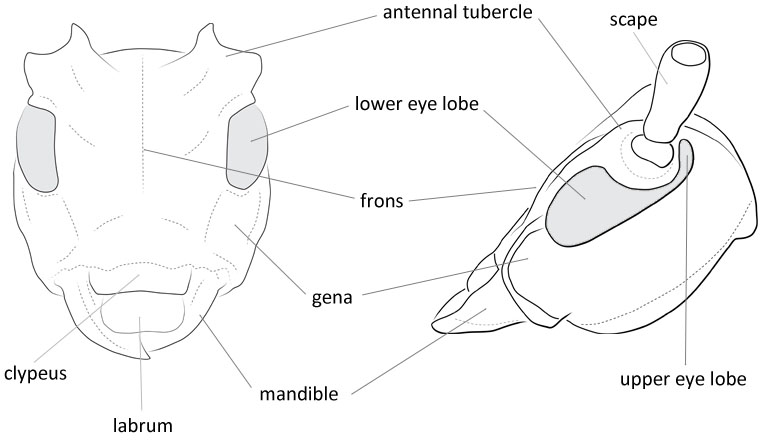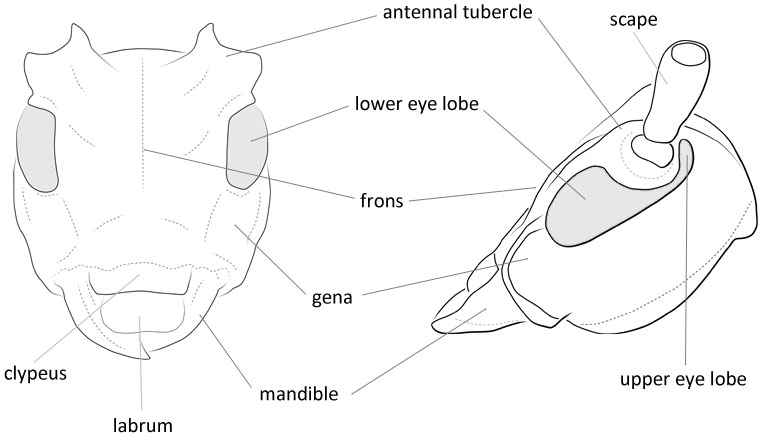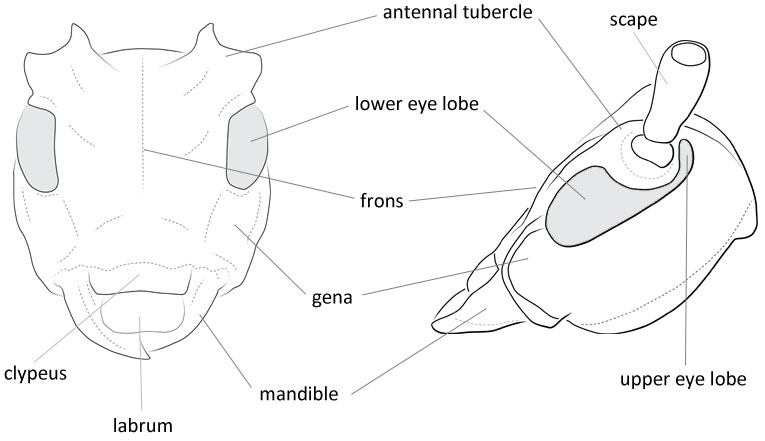Body length: 8–13 mm.
Eyes: eye interommatidial setaeseta:
a sclerotized hair-like projection of the cuticle
absent, eye deeply emarginateemarginate:
notched at the margin > half width, eye ommatidial density coarse.
> half width, eye ommatidial density coarse.
Antennaeantenna:
in larval and adult insects, paired segmented appendages, borne one on each side of the head, functioning as sense organs and bearing a large number of sensilla
: antennal length reaches between basebase:
the part of any appendage or structure that is nearest the body
and end of elytraelytron:
the leathery forewing of beetles, serving as a covering for the hind wings, commonly meeting opposite elytron in a straight line down the middle of the dorsum in repose
, antennal flagellar segments elongateelongate:
much longer than wide
, scapescape:
the first proximal segment of the antenna smooth/punctate at apexapex:
smooth/punctate at apexapex:
end of any structure distad to the base
, antennal segment 3 > scapescape:
the first proximal segment of the antenna .
.
Pronotumpronotum:
the upper and dorsal part of the prothorax
: pronotumpronotum:
the upper and dorsal part of the prothorax
shape subquadratesubquadrate:
not quite a square
, pronotumpronotum:
the upper and dorsal part of the prothorax
lateral armature acute spinespine:
a protuberance with an acute (sharp) distal end
.
Prosternum: prosternal processprosternal process:
a posterior extension of the prosternum between the coxae dilated at apexapex:
dilated at apexapex:
end of any structure distad to the base
, procoxal cavities closed posteriorly.
Elytraelytron:
the leathery forewing of beetles, serving as a covering for the hind wings, commonly meeting opposite elytron in a straight line down the middle of the dorsum in repose
: elytral length reaching or close to end of abdomen, elytral apicesapex:
end of any structure distad to the base
with tooth or spinespine:
a protuberance with an acute (sharp) distal end
, elytral color pattern present.
Legs: visible tarsomerestarsomere:
subdivision or article of the tarsus, usually numbering from two to five : 4, femora clavateclavate:
: 4, femora clavateclavate:
thickening gradually toward the tip
, protibial spursprotibial spur:
sclerotized spine(s) located at the distal tibia; can be single, double, or absent : 2, tarsal clawstarsal claw:
: 2, tarsal clawstarsal claw:
usually paired claws of the pretarsus, at the distal end of the leg simple.
simple.
Form moderate-sized, convex. Head with front short, transversetransverse:
broader than long
; genaegena:
the part of the cranium on each side below the eye short, about as long as width of lower eye lobeeye lobe:
short, about as long as width of lower eye lobeeye lobe:
used to refer to the upper or lower portion when the eye is emarginate or separated ; antennaeantenna:
; antennaeantenna:
in larval and adult insects, paired segmented appendages, borne one on each side of the head, functioning as sense organs and bearing a large number of sensilla
slender, shorter than body, scapescape:
the first proximal segment of the antenna cylindrical, short, third segment longer than scapescape:
cylindrical, short, third segment longer than scapescape:
the first proximal segment of the antenna , fourth shorter than third. Pronotumpronotum:
, fourth shorter than third. Pronotumpronotum:
the upper and dorsal part of the prothorax
about as broad as long, sides strongly, acutely tuberculate with large asperities before and behind tubercles; basebase:
the part of any appendage or structure that is nearest the body
broadly impressed; prosternum shallowly excavated, coxal cavities strongly angulate externally; mesosternummesosternum:
sternum of the mesothorax
with intercoxal process gradually arcuatearcuate:
arched or bow-like
; metasternum retracted. Elytraelytron:
the leathery forewing of beetles, serving as a covering for the hind wings, commonly meeting opposite elytron in a straight line down the middle of the dorsum in repose
basally gibbose; strongly convex; apicesapex:
end of any structure distad to the base
produced with long, blunt spines. Legs with femora moderately clavateclavate:
thickening gradually toward the tip
. Abdomen with first and last sternites broad (Linsley and Chemsak 1984Linsley and Chemsak 1984:
Linsley EG and Chemsak JA. 1984. The Cerambycidae of North America. Part VII, No. 1. Taxonomy and Classification of the Subfamily Lamiinae, Tribes Parmenini Through Acanthoderini. University of California Press, Berkeley and Los Angeles. 258 pp.).
The acuminate apicesapex:
end of any structure distad to the base
of the elytraelytron:
the leathery forewing of beetles, serving as a covering for the hind wings, commonly meeting opposite elytron in a straight line down the middle of the dorsum in repose
and large lateral asperities anterior and posterior to an acute tubercletubercle:
a small knoblike or rounded protuberance
of the pronotumpronotum:
the upper and dorsal part of the prothorax
make this genus distinctive.
New World: western North America from Alaska to northern California
Old World: eastern Asia and Japan
New World: Thuja, Pseudotsuga, Tsuga, Acer, Alnus, Salix, Oplopanax, Rhamnus
Old World: Abies, Tsuga, Acer, Alnus, Cornus, Sorbus
Two species, P. metallica in Old World under subgenus Phlyctidola. Both species with host records of conifers and broadleaf trees. Larvae under dead and wet bark.
Plectrura Mannerheim, 1852
Phlyctidola Bates, 1884